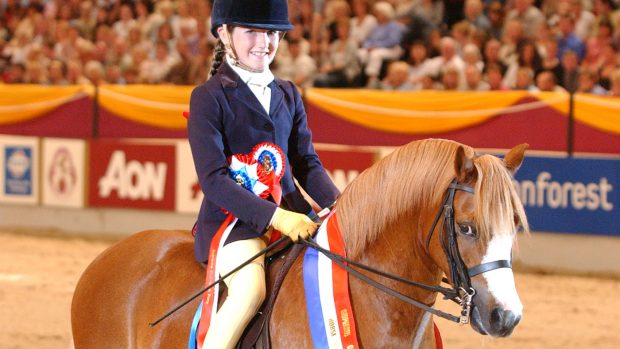The Welsh Pony and Cob Society (WPCS) defines the Welsh section C — also known as the Welsh Pony of Cob Type — as a stronger counterpart of the Welsh pony, but with cob blood.
The height should not exceed 13.2hh (137.2cm) and there is no minimum height limit. The Welsh C is a hugely popular choice of pony for both adults and children and is a common sight both in the show ring and across other performance disciplines.
In contrast to the Welsh section B which has the same height limit, the C should be more cob-like and compact with a greater amount of body and bone.
The WPCS provides the following standard for both the Welsh C and the D, suggesting that the C should be in effect, smaller versions of their cob counterparts.
General character: Strong, hardy and active, with pony character and as much substance as possible
Head: Full of quality and pony character. A coarse head and Roman nose are most objectionable
Eyes: Bold, prominent and set widely apart
Ears: Neat and well set
Neck: Lengthy and well carried. Moderately lean in the case of mares, but inclined to be cresty in the case of mature stallions
Shoulders: Strong but well laid back
Forelegs: Set square and not tied in at the elbows. Long, strong forearms. Knees well developed with an abundance of bone below them. Pasterns of proportionate slope and length. Feet well-shaped. Hooves dense. When in the rough, a moderate quantity of silky feather is not objected to but coarse, wiry hair is a definite objection.
Middlepiece: Back and loins, muscular, strong and well-coupled. Deep through the heart and well-ribbed up.
Hindquarters: Lengthy and strong. Ragged or drooping quarters are objectionable. Tail well-set on.
Hind legs: Second thighs, strong and muscular. Hocks, large, flat and clean, with points prominent, turning neither inward nor outwards. The hind legs must not be too bent and the hock not set behind a line falling from the point of the quarter to the fetlock joint. Pasterns of proportionate slope and length. Feet well-shaped. Hooves dense.
When it comes to colour, the C can be any, except piebald and skewbald. Many sport white socks and stockings.
The action should be: “free, true and forcible. The knee should be bent and the whole foreleg should be extended straight from the shoulder and as far forward as possible in the trot. Hocks flexed under the body with straight and powerful leverage.”
The Welsh C can also be a popular cross for producing progeny suitable for any discipline.
The Welsh C was originally developed by crossing the Welsh Mountain Ponies (Section As) with the larger and heavier Welsh Cobs (Section Ds) — the result is this small cob type. According to the WPCS, Welsh Mountain Ponies are believed to be descended from the Celtic pony and existed in the mountains of Wales for over a thousand years.
Today, section Cs can be either the result of a cross between the section A and the Welsh Cob or can be bred directly from two section C ponies.
In October 2018, at the annual autumn cob sales held at The Royal Welsh Showground in Builth, the six-year-old Welsh C stallion Tyrllawn Rolls-Royce sold for a record-breaking price of £45,000 on the final day of the auction. This is the highest price a Welsh pony has ever been sold for.

Danwood Llewellyn topped the 2018 Welsh section C class at HOYS, before standing reserve overall mountain and moorland ridden champion.
Welsh section Cs often have their own breed classes but are sometimes required to compete against Welsh Ds. They have their own final at the Horse of the Year Show (HOYS) and the 2018 winner was Danwood Llewellyn (above) ridden by his breeder Linda Atkinson.
In 2013, Maggie and Beth Simons’ stallion Yrallt May Day Surprise was crowned overall ridden mountain and moorland pony of the year at the NEC. In the same year, champion of the prestigious Cuddy supreme in-hand championship was the 15-year-old mare Synod Lady Lillian, owned by Gareth Williams.
Welsh Cs also excel in the working hunter ring and are often seen at the top of native classes across the country. Georgia Darlington and her own Tynwydd Good Friday was the last C to net the HOYS working hunter pony of the year title in 2016, after scooping the 133cm class.
Their athleticism also makes them popular all-rounders and they can excel on the show jumping circuit or can be successful dressage ponies. The section C can be one of the most versatile native breeds for varying age of riders, perhaps more so than the section B due to their sturdier stature, meaning adult riders can be very comfortable them.




